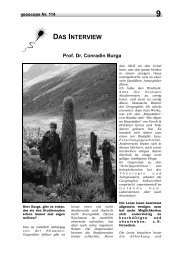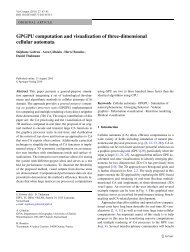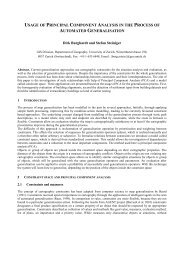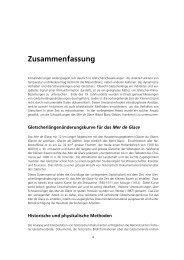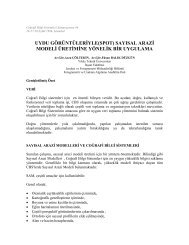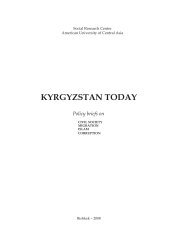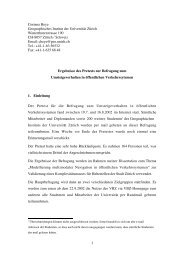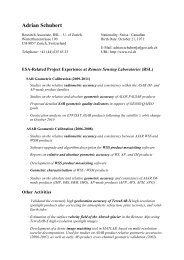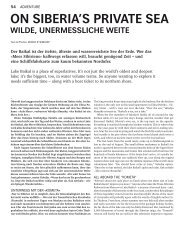Pedogenesis of Chernozems in Central Europe — A review
Pedogenesis of Chernozems in Central Europe — A review
Pedogenesis of Chernozems in Central Europe — A review
You also want an ePaper? Increase the reach of your titles
YUMPU automatically turns print PDFs into web optimized ePapers that Google loves.
(2003) <strong>in</strong>dicated that the patchy distribution <strong>of</strong> <strong>Chernozems</strong><br />
could be expla<strong>in</strong>ed by prehistoric anthropogenic <strong>in</strong>fluence on<br />
Chernozem pedogenesis.<br />
7. Man and fire <strong>—</strong> The miss<strong>in</strong>g factors?<br />
7.1. Charred organic matter as colour<strong>in</strong>g agent<br />
Up to now, the dark brown to black colour <strong>of</strong> Chernozem A<br />
horizons was attributed to humic acids that cover clay m<strong>in</strong>erals<br />
or are bound between the layers <strong>of</strong> clay m<strong>in</strong>erals. These resistant<br />
clay–humus-complexes rema<strong>in</strong>ed <strong>in</strong> the argic subsoil horizons<br />
<strong>of</strong> leached and degraded <strong>Chernozems</strong> or Phaeozems (Greenland,<br />
1971; Gebhardt, 1971; Rochus, 1979).<br />
In contrast, some black soils seemed to <strong>in</strong>herit their dark<br />
colour from charred organic carbon or black carbon. The term<br />
black carbon describes a cont<strong>in</strong>uum <strong>of</strong> charred organic material,<br />
and black carbon could be used as a marker for vegetation fire.<br />
Up to 45% <strong>of</strong> the total organic carbon <strong>in</strong> <strong>Chernozems</strong> <strong>of</strong> Lower<br />
Saxony consisted <strong>of</strong> black carbon (Schmidt et al., 2002). In<br />
North American <strong>Chernozems</strong>, the proportion reached from 35%<br />
(Skjemstad et al., 2002; Glaser and Amelung, 2003) to 80% <strong>of</strong><br />
soil organic carbon (Ponomarenko and Anderson, 2001).<br />
Russian <strong>Chernozems</strong> yielded 17% black carbon (BPCA) up to<br />
a depth <strong>of</strong> 60 cm (Rodionov et al., 2006). Black carbon<br />
contributes to the highly aromatic and recalcitrant soil organic<br />
matter and could be recovered <strong>in</strong> the chemical fraction def<strong>in</strong>ed<br />
as humic acids (Haumaier and Zech, 1995; Skjemstad et al.,<br />
1996). Schmidt et al. (2002) calculated that one to seven fires<br />
would produce 1.7 g black carbon kg − 1 soil. Gehrt et al. (2002)<br />
assessed an annual <strong>in</strong>put <strong>of</strong> 40 kg black carbon ha − 1 over<br />
1000 years to reach the proportion <strong>of</strong> 20% black carbon <strong>in</strong> the<br />
soil organic matter <strong>of</strong> <strong>Chernozems</strong> <strong>of</strong> Lower Saxony.<br />
However, black carbon represents a cont<strong>in</strong>uum <strong>of</strong> charred<br />
material, and the acquisition <strong>of</strong> black carbon data is still<br />
troublesome. A generally accepted def<strong>in</strong>ition <strong>of</strong> black carbon<br />
does not yet exist. Different analytical protocols are used to<br />
measure different fractions <strong>of</strong> black carbon. These protocols are<br />
based on the concept <strong>of</strong> chemical or thermal oxidation <strong>of</strong> labile<br />
organic matter and subsequent measurement <strong>of</strong> the relatively<br />
<strong>in</strong>ert black carbon. The measurement <strong>of</strong> different fractions <strong>of</strong><br />
black carbon with different methods obta<strong>in</strong>s results that are not<br />
directly comparable (Bird, 1997; Schmidt et al., 2001).<br />
Despite methodological problems, there is evidence for black<br />
soils hav<strong>in</strong>g been formed as a result <strong>of</strong> black carbon<br />
<strong>in</strong>corporation <strong>in</strong> soils through vegetation burn<strong>in</strong>g <strong>in</strong> Australia<br />
(Skjemstad et al., 1996, 1997) and Africa (Kuhlbusch et al.,<br />
1996) or through the accumulation <strong>of</strong> hear thashes <strong>in</strong> Amazonian<br />
Brazil (Terra Preta; Glaser et al., 2001). Although the processes<br />
<strong>of</strong> <strong>in</strong>corporation and colour<strong>in</strong>g are not yet clearly understood, soil<br />
colour (lightness) and amount <strong>of</strong> aromatic carbon, typical for<br />
black carbon, correlate (Spielvogel et al., 2004).<br />
Black soil horizons <strong>in</strong> the Lower Rh<strong>in</strong>e Bas<strong>in</strong> (Northwest<br />
Germany) could be relics <strong>of</strong> anthropogenic fire management.<br />
The black soils occurred <strong>in</strong> patches, were always connected to<br />
anthropogenic pits and their soil properties differed very clearly<br />
from the surround<strong>in</strong>g Luvisols. The soil material conta<strong>in</strong>ed<br />
E. Eckmeier et al. / Geoderma 139 (2007) 288–299<br />
charcoal and black carbon (19-45% <strong>of</strong> soil organic carbon). The<br />
radiocarbon ages from charcoal and black carbon ranged from<br />
the Mesolithic period to the Middle Ages, with an emphasis <strong>in</strong><br />
the Late Neolithic Period 4400–2200 BC) (Gerlach et al., <strong>in</strong><br />
press). For the Late Neolithic Period, fire management could be<br />
supported by pollen records for Northern <strong>Europe</strong> (Iversen,<br />
1941; Kalis and Meurers-Balke, 1998) and presumably also for<br />
the Lake Constance area (Rösch, 1993).<br />
There is evidence that, next to black carbon or charcoal<br />
content, magnetic susceptibility <strong>of</strong> soil material may reflect past<br />
fires. Hanesch and Scholger (2005) measured the magnetic<br />
susceptibility <strong>in</strong> different Lower Austrian soils and found that<br />
<strong>Chernozems</strong> have the highest signals <strong>of</strong> all soil types<br />
(77×10 −8 m 3 kg −1 ). Bulgarian <strong>Chernozems</strong> gave similar values<br />
<strong>of</strong> 80×10 −8 m 3 kg −1 <strong>in</strong> the topsoil and 40×10− −8 m 3 kg −1 <strong>in</strong><br />
the subsoil, respectively (Jordanova and Jordanova, 1999). The<br />
transformation <strong>of</strong> goethite or ferrihydrite to maghemite takes part<br />
dur<strong>in</strong>g heat<strong>in</strong>g (Nørnberg et al., 2004) at temperatures as low as<br />
220 °C (Sidhu, 1988). Zanelli et al. (<strong>in</strong> press) observed <strong>in</strong>-situ<br />
formation <strong>of</strong> maghemite up to 0.5 m deep <strong>in</strong> soils affected by<br />
forest fires <strong>in</strong> Southern Switzerland.<br />
Circumstantial evidence suggests that vegetation fire could<br />
be a new formation factor <strong>in</strong> the genesis <strong>of</strong> black soils. Natural<br />
fires emerge rarely <strong>in</strong> <strong>Central</strong> <strong>Europe</strong>an deciduous forests<br />
(T<strong>in</strong>ner et al., 1999). Therefore, vegetation fires ignited by<br />
humans may be a source for the black carbon found <strong>in</strong> <strong>Central</strong><br />
<strong>Europe</strong>an <strong>Chernozems</strong>.<br />
7.2. The <strong>in</strong>fluence <strong>of</strong> human activity<br />
Black soil remnants were <strong>of</strong> ten found <strong>in</strong> Neolithic settlement<br />
areas. Relics <strong>of</strong> black soils were preserved as fill<strong>in</strong>gs <strong>of</strong> pits,<br />
ditches or postholes and as rema<strong>in</strong>s <strong>of</strong> prehistoric surfaces.<br />
These black soils were described as relics <strong>of</strong> <strong>Chernozems</strong>,<br />
which should have been widespread <strong>in</strong> the loess-covered areas<br />
<strong>in</strong> Early Neolithic times. Scheffer and Meyer (1963) developed<br />
a model for Chernozem formation <strong>in</strong> Lower Saxony accord<strong>in</strong>g<br />
to their observations on archaeological excavation sites. On<br />
some exam<strong>in</strong>ed sites, e.g. <strong>in</strong> the Wetterau loess area (Hesse), the<br />
black soil horizon <strong>in</strong> the prehistoric settlement area corresponded<br />
to the surround<strong>in</strong>g Phaeozems (Thiemeyer, 1989). On<br />
other sites, as <strong>in</strong> the Lower Rh<strong>in</strong>e Bas<strong>in</strong> (Schalich, 1981), the<br />
black soils clearly differed from the surround<strong>in</strong>g Haplic<br />
Luvisols. In some cases, a mixture <strong>of</strong> <strong>Chernozems</strong> and<br />
anthropogenic organic material was described (Schwarz,<br />
1948; Meyer, 1966; Grote, 1977).<br />
Geochemical analysis <strong>of</strong> black soil material from prehistoric<br />
settlements and adjacent Phaeozems revealed that their chemical<br />
properties and pedogenesis were different. Pit fill<strong>in</strong>gs <strong>in</strong> a<br />
Neolithic settlement (Murr; Bavaria) conta<strong>in</strong>ed high amounts <strong>of</strong><br />
charred organic material (23–70% <strong>of</strong> total organic carbon), and<br />
the concentrations <strong>of</strong> charred material correlated with the soil<br />
colour. The dark material <strong>in</strong> the settlement area was a mixture <strong>of</strong><br />
deposited waste material and soil (Schmid et al., 2001, 2002).<br />
Baumann et al. (1964) analysed black pit fill<strong>in</strong>gs and the<br />
black surface layer <strong>in</strong> a Neolithic settlement. The pit fill<strong>in</strong>gs<br />
consisted <strong>of</strong> organic material, ma<strong>in</strong>ly waste or litter, which was<br />
295






